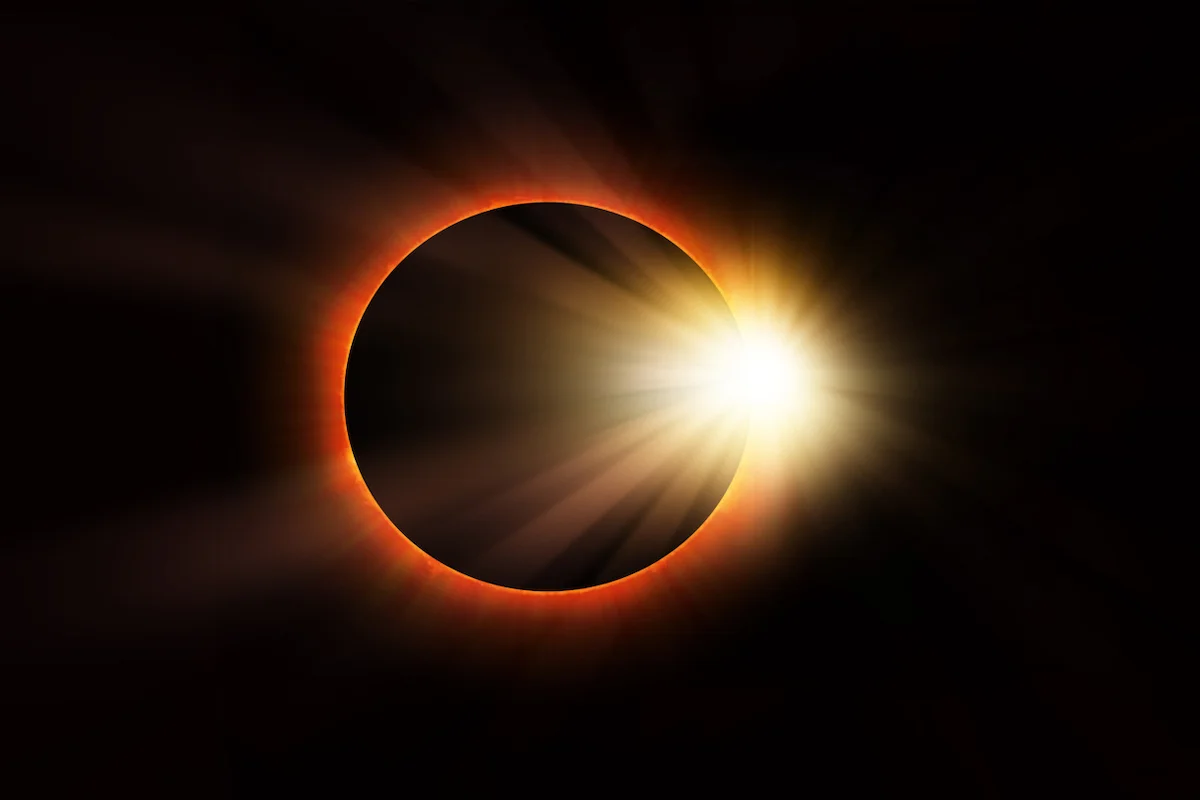Introduction:
Solar eclipses, one of nature’s most spectacular celestial events, have fascinated humanity for millennia. From ancient civilizations to modern astronomers, people around the world have marveled at the awe-inspiring sight of the moon passing in front of the sun, temporarily casting a shadow over the Earth. This essay delves into the phenomenon of solar eclipses, examining their scientific basis, cultural significance, and the experience of witnessing these rare events.
Understanding Solar Eclipses:
A solar eclipse occurs when the moon passes between the Earth and the sun, obscuring all or part of the sun’s light. This celestial alignment can result in three different types of solar eclipses: total, partial, and annular.
- Total Solar Eclipse: During a total solar eclipse, the moon completely covers the sun, creating a brief period of darkness known as totality. In this rare and mesmerizing spectacle, the sun’s outer atmosphere, or corona, becomes visible, along with bright stars and planets in the sky.
- Partial Solar Eclipse: In a partial solar eclipse, the moon only partially covers the sun, casting a shadow over a portion of the Earth’s surface. While not as dramatic as a total eclipse, partial eclipses still offer a captivating display as the moon appears to take a “bite” out of the sun.
- Annular Solar Eclipse: An annular solar eclipse occurs when the moon is too far from the Earth to completely cover the sun’s disk. As a result, a ring of sunlight, or annulus, remains visible around the edges of the moon, creating a striking “ring of fire” effect.
The occurrence of solar eclipses is relatively rare due to the precise alignment required of the Earth, moon, and sun. On average, a total solar eclipse is visible from any given location on Earth only once every 375 years, making each event a highly anticipated and celebrated occurrence.
Scientific Significance:
Solar eclipses provide scientists with valuable opportunities to study the sun, moon, and Earth’s atmosphere. During a total solar eclipse, the moon’s shadow allows researchers to observe the sun’s outer atmosphere, or corona, in unprecedented detail.
The corona, which is normally obscured by the sun’s intense glare, contains valuable information about the sun’s magnetic field, solar wind, and other solar phenomena. By studying the corona during eclipses, scientists can gain insights into solar activity and better understand the sun-Earth connection.
Solar eclipses also serve as a reminder of the delicate balance of our solar system and the interconnectedness of celestial bodies. The precise alignment required for an eclipse to occur highlights the intricate dance of the Earth, moon, and sun as they move through space.
Cultural and Historical Perspectives:
Throughout history, solar eclipses have been viewed with a mixture of awe, fear, and reverence by cultures around the world. Ancient civilizations often interpreted eclipses as omens or supernatural events, associating them with the wrath of gods or impending disasters.
In many cultures, rituals and ceremonies were performed during eclipses to ward off evil spirits or appease celestial deities. These practices varied widely depending on cultural beliefs and traditions, but they often involved offerings, prayers, and elaborate ceremonies conducted by priests or shamans.
In some societies, solar eclipses were seen as auspicious events, heralding new beginnings or signaling important transitions. For example, the ancient Chinese believed that eclipses were caused by a celestial dragon devouring the sun, and they would make loud noises and shoot arrows into the sky to frighten the dragon away.
In modern times, solar eclipses continue to captivate the public imagination, drawing thousands of spectators to prime viewing locations around the world. Eclipse chasers, or “umbraphiles,” travel great distances to witness these rare events firsthand, often documenting their experiences through photography and videography.
The Path of Totality:
One of the most anticipated aspects of a total solar eclipse is the path of totality, the narrow corridor where the moon’s shadow completely covers the sun. This path, which can span thousands of miles but is typically only a few dozen miles wide, is where observers can experience the awe-inspiring beauty of totality.
During totality, the sky darkens to twilight, stars and planets become visible, and the sun’s corona blazes in the sky like a cosmic halo. The sudden transition from day to night creates a surreal and mesmerizing atmosphere, evoking a sense of wonder and awe in those fortunate enough to witness it.
The path of totality varies with each eclipse, determined by the geometry of the Earth, moon, and sun. Eclipse enthusiasts carefully plan their trips to ensure they are positioned within the path of totality, often traveling to remote or exotic locations to maximize their chances of experiencing the full spectacle of a total solar eclipse.
Safety Precautions:
While solar eclipses are awe-inspiring events, it’s essential to observe them safely to protect your eyesight. Looking directly at the sun, even during an eclipse, can cause permanent eye damage or blindness. Specialized eye protection, such as eclipse glasses or solar filters, must be used to view the sun safely.
Additionally, indirect viewing methods, such as pinhole projectors or solar telescopes, can be used to observe the eclipse without looking directly at the sun. These methods allow viewers to safely enjoy the event while protecting their eyes from harm.
Conclusion:
Solar eclipses are awe-inspiring celestial phenomena that have captivated humanity for centuries. From ancient civilizations to modern astronomers, people around the world have marveled at the beauty and wonder of these rare events. Whether viewed as omens, supernatural occurrences, or scientific opportunities, solar eclipses continue to hold a special place in the collective imagination of humanity.
As we look to the skies in anticipation of the next eclipse, let us remember the profound significance of these celestial events and the opportunity they provide to deepen our understanding of the universe. Whether experienced from the path of totality or observed from afar, a solar eclipse is a reminder of the interconnectedness of the cosmos and the wonder of the natural world.






